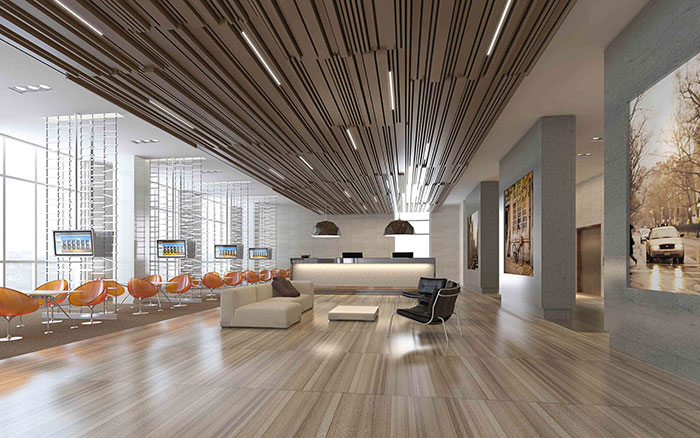New Ceiling Panels that Enhance Sustainability and Sound Absorption
 Other News
Other News Subscribe to newsletter
Subscribe to newsletter
| 11 Feb 2014 |
As architects in the MENA region design increasingly complex buildings with varying ceiling heights, Dutch manufacturer Hunter Douglas has released a new range of adjustable and environmentally-friendly ceiling panels to enhancesustainability and sound absorption.
Buildings are responsible for one-third of greenhouse gas emissions, according to the World Green Building Council. In response, the UAE has led the region with sustainability initiatives, including Dubai Municipality’s Green Building Codes totake effect in January 2014, and Abu Dhabi’s International Building Code and Estimada Pearl Rating System.

Standard ceiling panels are not energy efficient, as they prevent concrete from transferring warmth or cold to rooms, and are not effective at absorbing sound. In contrast, Hunter Douglas’ acoustic ceiling panels offer more spacing, and can be adapted to different heights, enhancing energy and acoustic performance. Depending on the interior climate and acoustic requirements, panels can be combined panels to achieve a sound absorption level of αw=0.85.
Pieter van Rees, Marketing Manager, Hunter Douglas, said: “These acoustic ceiling panels are like building blocks that you can combine in countless possible ways, and click them into the ceiling wherever you want. Architects have found these options highly inspiring. We offer them a lot of extras: they have the option of creating create a quiet-looking ceilingby minimizing variations, or an extravagant look, and even create a 3D effect.”
Hunter Douglas offers three types of ceiling panelsthat are made from 90 percent recycled aluminium: the B panels (20 mm high), BD panels (40 mm high), and BXD panels (60 mm high).Each ceiling panel is available in a wide range of widths,from 30 mm to 180 mm.
In 2010, Hunter Douglas supplied the Dutch government organization WaterschapBrabantse Delta with BD ceiling panels that were 40 mm high by 30 mm wide, with a 20 mm joint.
Pieter van Ress, Marketing Manager, Hunter Douglas, said: “We wanted to reduce the negative effect on thermally activated concrete, and optimize their system by making the ceiling more open. To achieve that goal, we mounted the panels at a greater distance from one another, broadened the joint from 20 mm to 30 mm, and installed BXD panels with a height of 60 mm. The result is improved acoustic performance, as well as an improved exchange of heat or cold between the concrete cores and the rooms in the building.”
BXD panels, which give ceilings a smooth look that appear to be of one piece, achieve a high average sound absorption ratio of αw=0.50. Combining panels of different widths can lead to an even higher sound absorption ratio of αw=0.85.
All BXD panels are fireproof-tested individually and in combination, based on the EN 13501-1 standard, and as a result are flash resistant.




